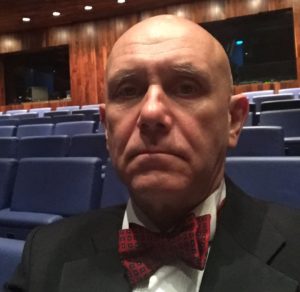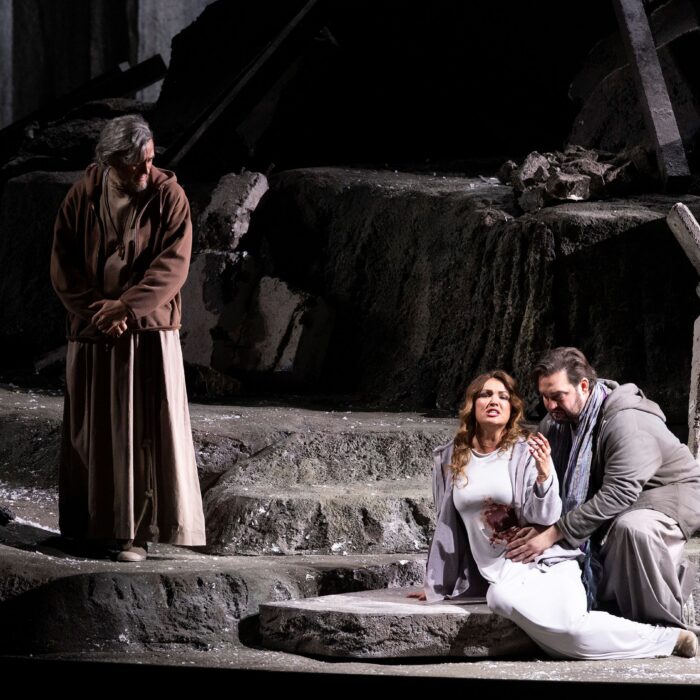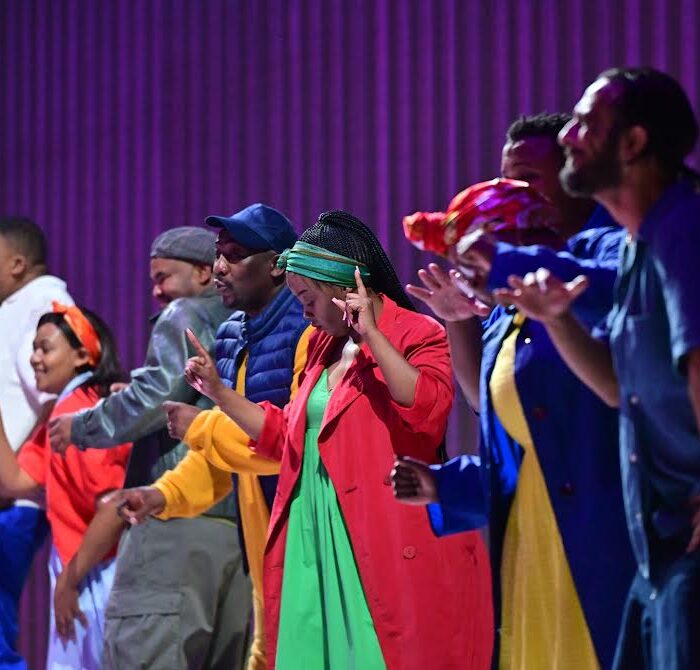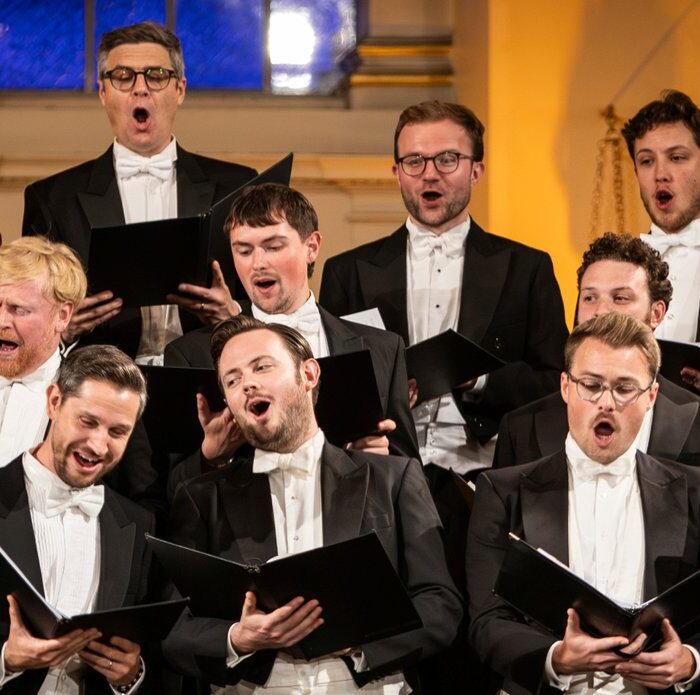
The Slovak National Theater Opera 2024 Review: The Cunning Little Vixen
Adriana Kučerová’s Feisty Vixen Leads A Dark Production
By Alan Neilson(Photo: Marek Olbrzymek)
It is too often the case that Janáček’s “The Cunning Little Vixen” is presented as an opera for children, no doubt because it has lots of furry animals that talk and sometimes act like humans, although it is also probably a reaction to the fact that Janáček’s inspiration for the opera came from a cartoon strip in his local paper. Even in productions that steer clear of such a presentation, the readings tend to be heavily sentimentalized, so that it becomes a tale that tugs on the heartstrings when the poor vixen is shot by Harašta, the poacher; as the opera draws towards its conclusion, we are, however, comforted by the forester, who, on seeing a young fox cub, reflects on the inevitable cycle of life and death that affects man and beast alike. The Slovak National Theatre Opera, however, managed to transcend such sentiments with a production that captured the cruelty of all the characters involved, both human and vulpine, and which unequivocally sets the behavior of the humans in a far more negative light with far reaching disastrous consequences.
Daubnerová Unsentimental Tale of Exploitation and Cruelty
It is, of course, impossible for any production to free itself from the anthropomorphic nature of the animals, which is always going to exist given the fact that they talk and exhibit very human reactions. However, the director, Sláva Daubnerová, ensured that this did not end up magnifying the sentimental aspects of the work. Rather, she allowed the animals to embrace both their positive and negative human qualities, so that the courting scene between Sharp Ears and Gold Stripe was very recognizably human, down to the male fox offering the vixen not just a dead rabbit but also tobacco and alcohol. The vixen was also portrayed as a very vain animal who enjoyed looking at herself in the mirror and saw herself as the queen of the forest after kicking the badger from his den. It was a clever interpretation as it presented the animals with negative traits, which acted as a barrier to an overly sentimental reaction from the audience.
Moreover, Daubnerová was also keen to play up the wild nature of the animals themselves, in which play, aggression and killing were part of life. The vixen and her family of cubs were seen playing happily in the forest, but she was equally at ease chasing the badger from his den or slaughtering the rooster and the chickens simply because she could. She was bold and sly and deliberately taunted those around her, including the humans that crossed her path. She was wild; she was not playing a role in a picture book story.
It was a brutal depiction of forest life, in which the lives of the animals and the people cross with unpleasant consequences. The forester caged the animals in what can only be described as something akin to a concentration camp, with the dog acting as a guard, dressed suitably in a semi-militaristic costume. The vixen was brutally maltreated, hung up by her feet in the air in chains. The chickens also suffered at the forester’s hands, exemplified by one chicken, who covered in blood, found laying eggs a painful experience. There was a lot that was uncomfortable to watch, and it successfully managed to muscle out the sentimental.
None of the human characters were given a sympathetic reading; they were garrulous drunks who spent their evenings letting each other know their opinions, oblivious to the suffering of the animals or to the damage they were doing to the planet, which they viewed as no more than a resource, made clear by the fox fur coats lowered from the ceiling after the poacher’s killing spree, in which the vixen was just one of his victims. Even the forester’s sentimental musings were clearly an aberration, and he would, no doubt, soon return to his usual ways.
The brutality and destruction wreaked upon the forest by the humans was reinforced by the scenographer, Volker Hintermeier, who covered the stage with a dark forest of dead trees. It was a message that Daubnerová added to with the introduction of a figure representing the spirit of nature, who appeared occasionally during the performance, either fleeing from the poacher’s gun or in a symbolically strong image in the final scene in which, dressed as a bride, she sat on a proud looking stag.
Hintermeier’s set was not only instrumental in establishing the figurative and symbolic darkness of the forest, but it was also expertly designed to facilitate the drama. Often, productions of “The Cunning Little Vixen” are undermined by the rigidity of the sets, which are unable to move swiftly between the forest, the forester’s house, and the inn, which can lead to a fractured presentation. His use of the rotating stage not only overcame this problem, but it meant that the pattern of the forest landscape was in a constant state of change, where the animals would appear and disappear from among the trees, the vixen and her cubs would play and hide behind the rises of the earth, and the poacher or forester would suddenly appear from out of the darkness. The short musical interludes thus became opportunities to present life within the forest instead of just disruptive scene changes. Even the inn was designed to fit neatly into the forest so that its arrival on the rotating stage did not destroy the illusion.
The costumes designed by Tereza Kopecká were an interesting mix of traditional late 19th century clothing, as in the case of the forester; Alice in Wonderland absurdities, such as the school teacher with a top hat that must have been a meter in height; with the animals dressed in human clothes, animal costumes, or a combination of the two. It made for an imaginative mix that was visually engaging and successfully reflected the characters. They were perhaps the only aspect of the production that stepped into the world of the comic book, but it worked well.
Valčuha Offers Hope With A Life-affirming Reading
Although it was a dark reading, both visually and in terms of its message, Janáček’s life-affirming score was given a strong, emotionally warm performance by the SND Opera Orchestra under the baton of the conductor, Juraj Valčuha. It was also a dramatically strong and detailed presentation, in which the management of rhythm, pace and dynamics were sensitively aligned to the onstage drama, capturing the full range of the characters’ feelings, ranging from the playful joy of the vixen with her cubs to the aggressive behavior of the forester. Melodies were beautifully elicited, atmospheres sensitively developed, and the sumptuous passages of expansive music were allowed to take wing and fill the auditorium. It acted as perfect counterbalance to Daubnerová’s staging, so that the destructive and cruel were set alongside the restorative qualities and hopes that man can discover in the natural world and keep despair at bay.
With its large cast, consisting of the principal parts, numerous small roles and large chorus, the stage was often bustling with movement as the animals and humans went about their business. It also required plenty of energy from many of the singers, especially the foxes, as they gamboled and moved through the forest. All engaged fully with their roles and made strong impressions.
Soprano Adriana Kučerová was a feisty, wild, bold and loving vixen who embraced life. Her courtship with Gold Stripe and her loving relationship with her cubs were sensitively portrayed, yet she could be provocative and vicious. Vocally, she produced an excellent performance; the voice was firm, expressive and agile with a secure and pleasing upper register, which she used expertly to develop her character.
The vixen’s younger self was played by Petra Simonová, whose fresh sounding and flexible voice were perfect for the role.
Baritone Svatopluk Sem, cast as the forester, Revirnik, produced a compelling performance. There was little about his character one could sympathize with; his forester was a single-minded, aggressive individual that dominated the other characters, human and non-human alike, with, of course, the exception of the vixen, whose untamable nature brought out his frustrations. His singing was forceful, expressive, able to move easily above the orchestra, and clearly articulated, which allowed him to successfully bring out the negative attributes of the forester.
The male fox, Gold Stripes, for reasons that were not apparent, was portrayed as a female fox with its pubic hair vulgarly exposed to reinforce the fact. The role was given an expressively convincing performance by mezzo-soprano Jana Kurucová.
The Schoolmaster, played by tenor Ondrej Šaling, spent most of his time on stage drunk, while his drinking companion, the parson, played by bass Michal Onufer, came across as a suitably ‘dry old stick.’
The dog, Lapák, was presented as vicious and authoritarian by mezzo-soprano Monika Fabianová.
Baritone Martin Morháč, playing the role of Harašta, the poacher, came across as a chancer, a less intense version of the forester but equally oblivious to the health of the forest from which he makes his living.
The cast was completed by soprano Jolana Fogašová as the owl and the forester’s wife; tenor Pavol Muchz as Pásek, the innkeeper; Viktória Svetliková as Mrs. Pásková and the woodpecker; and Vanessa Čierna as the rooster and the jay.
The SND Opera Chorus was kept busy playing the roles of hens, forest creatures and voices of the forest, while a children’s chorus played the role of the fox cubs.
It was very satisfying to see “The Cunning Little Vixen” as a drama shorn of its sentimental trappings and without the usual ‘an opera suitable for children’ label attached. Instead, thanks to Daubnerová’s direction, it became a dark tale of human exploitation and devastation, and in doing so, it successfully highlighted the beauty and spiritual restorative power of nature that pervades Janáček’s music.



